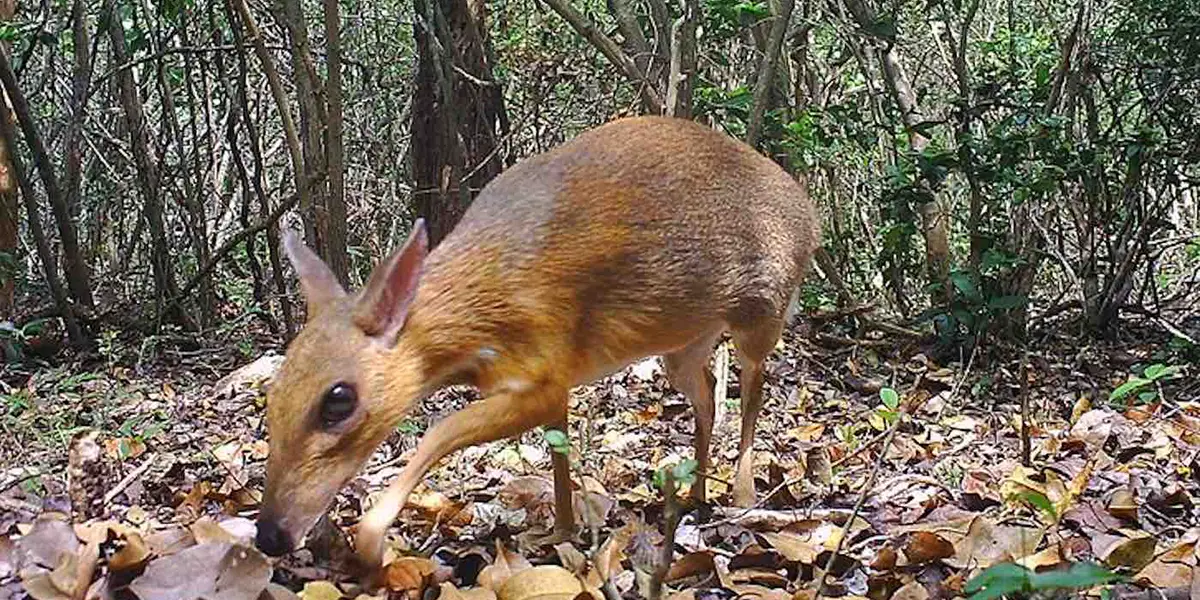Mouse-Size Deer Believed To Be Extinct Re-Emergences In Vietnam Forest
Tags: News

By Mandy Froelich / Truth Theory
After nearly three decades, the “silver-backed chevrotain” has re-emerged in the Vietnamese wilderness. The tiny, deer-like species is about the size of a rabbit and was last spotted in 1990.
Once researchers captured video and photographs of the mammal, it became the first mammal to be “rediscovered” on the Global Wildlife Conservation’s (GWC) top 25 most wanted lost species in the Search for Lost Species.
As GoodNewsNetwork reports, the GWC and their partners at the Southern Institute of Ecology and Leibniz Institute for Zoo and Wildlife Research made the discovery in southern Vietnam. The findings were recently published in the scientific journal Nature Ecology and Evolution.
The discovery has ignited additional efforts to protect chevrotain and other myserious creatures that inhabit Vietnam. “We had no idea what to expect, so I was surprised and overjoyed when we checked the camera traps and saw photographs of a mouse deer with silver flanks,” said An Nguyen, associate conservation scientist for GWC and expedition team leader. “For so long, this species has seemingly only existed as part of our imagination. Discovering that it is, indeed, still out there, is the first step in ensuring we don’t lose it again, and we’re moving quickly now to figure out how best to protect it.”
The first description of the chevrotain was documented in 1910 during a Russian expedition to Vietnam. Little else has been reported on the general ecology or conservation status of the species, however. As a result, the silver-backed chevrotain is one of the highest mammal conservation priorities in the Greater Annamite mountains.
Researchers were encouraged to search for the mouse-like deer after hearing about the mammal’s existence from local villagers and government forest rangers. The field team set three camera traps for five months in an area of southern Vietnam where locals indicated they might have seen the animal. 275 photos of the species were eventually snapped. Later, the team set up another 29 cameras in the same area; 1,881 more photographs of the chevrotain were captured over a period of five months.
“The rediscovery of the silver-backed chevrotain provides a big hope for the conservation of biodiversity, especially threatened species, in Vietnam,” said Hoang Minh Duc, head of the Southern Institute of Ecology’s Department of Zoology. “This also encourages us, together with relevant and international partners, to devote time and effort to further investigate and conserve Vietnam’s biodiversity heritage.”
There are currently 10 known species of chevrotains in the world; most are found in Asia. Despite their common English names, the mammal is neither a mouse nor a deer. Rather, it is the world’s smallest small ungulates (hoofed mammals). Chevrotains are shy and solitary creatures. They typically walk on the tips of their hooves and have two tiny fangs. An average chevrotain weighs just 11 pounds (5 kg).
Over 5000 people have downloaded our free ebook “Growth Hacking Tips And Rituals For Optimal Living” CLICK HERE to get your free copy now
Now that the mammal has re-emerged, a team is setting out to determine how large (and stable) the population of silver-backed chevrotains is. Wider distribution of the species will be assessed, as will threats to its survival. GoodNewsNetwork reports:
“As part of the first-ever comprehensive survey on the species, the team began camera trap surveys in October in two additional areas. They will use all of the information that they gather to develop a conservation action plan that strengthens enforcement and protection of the species across its range, building on the increased enforcement already put in place at the site of rediscovery.”
“It is an amazing feat to go from complete lack of knowledge of the wildlife of the Greater Annamites 25 years ago to now having this question mark of the silver-backed chevrotain resolved,” said Barney Long, GWC senior director of species conservation. “But the work is only beginning with the rediscovery and initial protection measures that have been put in place—now we need to identify not just a few individuals on camera traps, but one or two sites with sizable populations so that we can actually protect and restore the species.”
What are your thoughts? Please comment below and share this news!
IMAGE CREDIT: Global Wildlife Conservation
Leave Comment: